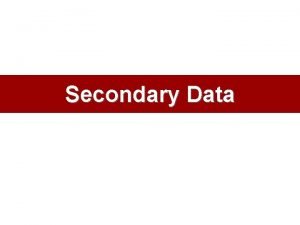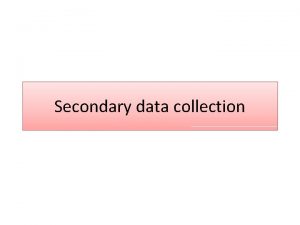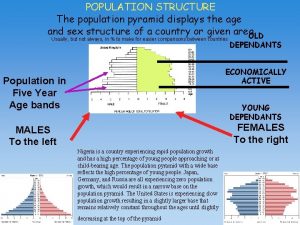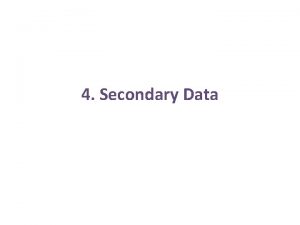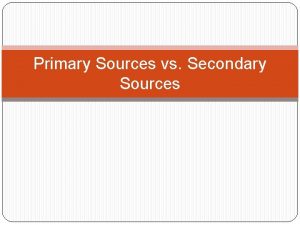Population and Demographic Data Secondary Sources of Demographic










- Slides: 10

Population and Demographic Data Secondary Sources of Demographic Data Homework: Today’s Topics: Lecture no. -18

To understand analyze the topics and issues of demography, one must have access to appropriate statistics. The availability of demographic statistics has increased dramatically since the 1970 s as a result of improved and expanded collection techniques, vast improvements in computing power, and the growth of the Internet (J. S. Siegel and D. A. Swanson, 2004). Demographic statistics may be viewed as falling into two main categories: primary and secondary.

Primary statistics are those that are the responsibility of the analyst and have been generated for a very specific purpose. The generation of primary statistics is usually very expensive and time-consuming. The advantages of primary data are that they are timely and may be created to meet very specific data needs. Secondary statistics differ in that they result from further analysis of statistics that have already been obtained.

These are regarded as data disseminated via published reports, the Internet, worksheets, and professional papers. These data may be disseminated freely, as is the case with public records, or for a charge, as with data clearinghouses. Their benefit is that they generally save a great deal of time and cost. The drawback is that data are usually collected with a specific purpose in mind—sometimes creating bias. Additionally, secondary data are, by definition, old data (Stewart and Kamins, 1993, p. 2).

Secondary Sources

Secondary sources may be either official or unofficial and include a wide variety of textbooks, yearbooks, periodical journals, research reports, gazetteers, and atlases.

International Data

• Index to International Statistics (IIS), published by the U. S. Congressional Information Service • The United Nations also publishes the Directory of International Statistics (DIS) • Some of the best resources on the Internet are supported by the following three agencies: the United Nations (un. org), the Population Reference Bureau (prb. org), and the International Programs Center of the U. S. Census Bureau (census. gov/ipc/www).

The Demographic Yearbook The Statistical Yearbook The Population Bulletin World Population Prospects The International Data Base (IDB) is a computerized data bank containing statistical tables of demographic and socioeconomic data for all countries of the world. • Of nongovernmental demographic and statistical resources, the Population Reference Bureau (PRB) is most prominent. Founded in 1929, the PRB is America’s oldest population organization. (www. prb. org) • • •

Question? ? ?
 Sources of demographic data
Sources of demographic data Data collection secondary data sources
Data collection secondary data sources Sources of population data
Sources of population data Syndicated data
Syndicated data Syndicated sources of secondary data
Syndicated sources of secondary data Disadvantages of secondary data
Disadvantages of secondary data Demographic transition model population pyramids
Demographic transition model population pyramids Print sources and web sources
Print sources and web sources Important of water management
Important of water management Primary secondary tertiary sources
Primary secondary tertiary sources Secondary sources
Secondary sources




